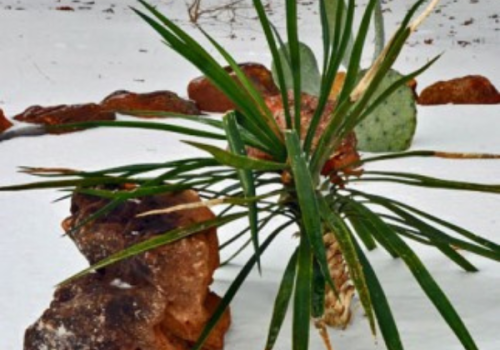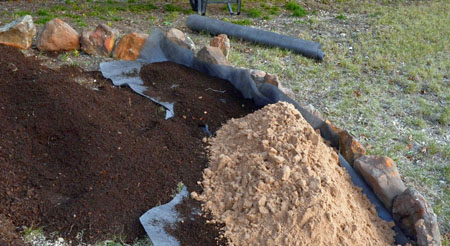Snowy Succulent Success
Written by Carol Welch

If you have gardened in Parker County for more than…oh…about 10 minutes, then you have encountered our diverse and often frustrating soil conditions. Even on the smallest properties, it is not uncommon to find clay snuggled up to a patch of pure sand; or a thin layer of soil sprinkled over several feet of rock; or a nice deposit of caliche (which is sedimentary rock composed of calcium carbonate). We have one of those, a patch of caliche that is, in the bar ditch that borders our property. It’s on the west side, so it gets several hours of scorching afternoon sun throughout the summer. As a result, nothing but the most tenacious weeds will grow there.
We have cultivated a nice stand of buffalo grass in the soil around the deposit, but even our attempts to amend the caliche have been unsuccessful on this barren patch due to the sloping hillside.
I have been considering possible solutions, and finally decided on a bed of succulents and cacti. Succulents are sometimes called “fat plants” because they have thickened areas of growth that are perfectly designed to store water. These hardy desert plants can withstand harsh conditions as well as poor soil. Most succulents are cultivated in a tropical climate, so the trick in Parker County is to select varieties hardy for our zone (7b).
In looking at the area, I decided on a bed of about 75 feet in circumference. This size covered the majority of the caliche without consuming too much of the encroaching buffalo grass. After attempting to dig into the caliche, we very quickly decided to have a raised bed. I say we, because I wasn’t the one digging. My husband, who is my faithful friend and hole-digger, was quick to agree on the matter. While succulents are quite capable of surviving in caliche, he was not capable of digging holes through solid rock without some heavy duty equipment. And in hindsight, we both prefer the look of the bed a bit raised off of the hillside.
The first order of business was a trip to our local supplier of stone to select rocks for the border. I chose rocks with an irregular shape in shades of brown and gray. These rocks blend nicely with the rest of our landscape.

I have been considering possible solutions, and finally decided on a bed of succulents and cacti. Succulents are sometimes called “fat plants” because they have thickened areas of growth that are perfectly designed to store water. These hardy desert plants can withstand harsh conditions as well as poor soil. Most succulents are cultivated in a tropical climate, so the trick in Parker County is to select varieties hardy for our zone (7b).
In looking at the area, I decided on a bed of about 75 feet in circumference. This size covered the majority of the caliche without consuming too much of the encroaching buffalo grass. After attempting to dig into the caliche, we very quickly decided to have a raised bed. I say we, because I wasn’t the one digging. My husband, who is my faithful friend and hole-digger, was quick to agree on the matter. While succulents are quite capable of surviving in caliche, he was not capable of digging holes through solid rock without some heavy duty equipment. And in hindsight, we both prefer the look of the bed a bit raised off of the hillside.
The first order of business was a trip to our local supplier of stone to select rocks for the border. I chose rocks with an irregular shape in shades of brown and gray. These rocks blend nicely with the rest of our landscape.

While we were selecting rocks and placing them on the trailer, I chose several to be placed near plants within the bed to add interest and color.
Once the rocks were in place, the next step was to place a professional grade landscape cloth on the slope and up around the interior edge of the rocks at the bottom of the hill. Normally this cloth is used to deter weeds; but for this bed, my goal was to retain the soil. Any soil placed on this slope is going be washed away by the first good rain.

The soil we used to fill the bed was a 50/50 mixture of sand and compost. Succulents and cacti aren’t very particular about soil, but they absolutely must have good drainage. Adding sand is an excellent way to ensure good drainage for this type of bed. Once the bed was complete, we had time to rest and consider the placement of the plants.
The best thing about succulents and cacti is that the plants are incredibly easy to propagate. Plants that live in the harshest of environments often have an excellent defense against damage. If a piece of the plant is broken off and lies on the ground for a few days, it will develop a dried callous over the open wound; and from that callous roots will grow down into the soil. If you have ever tried to get rid of a cactus by mowing over it, then you have experienced the miracle for yourself. In a matter of weeks, rather than one cactus, dozens will have rooted from the stray pieces.
I propagated my plants from parent plants that were healthy and hardy in the Parker County area. Because of the location of my caliche hillside, I needed plants that could sit in the west setting sun of August, as well as the frosty layers of sleet that would sit on my hillside in December. It took a bit of time searching out these hardy plants, but the results were well worth it. Some of the plants you will find in my bed include desert spoon, Spanish dagger, barrel cactus, spineless prickly pear, agave, and yucca.
We installed the bed in late fall; and as you can see from the pictures, we had a snowy succulent success story during our recent winter ice storm. My barren hillside is now an interesting and unexpected display of some of the hardiest plants in Parker County. Overall, I’d say the results are quite satisfying.
